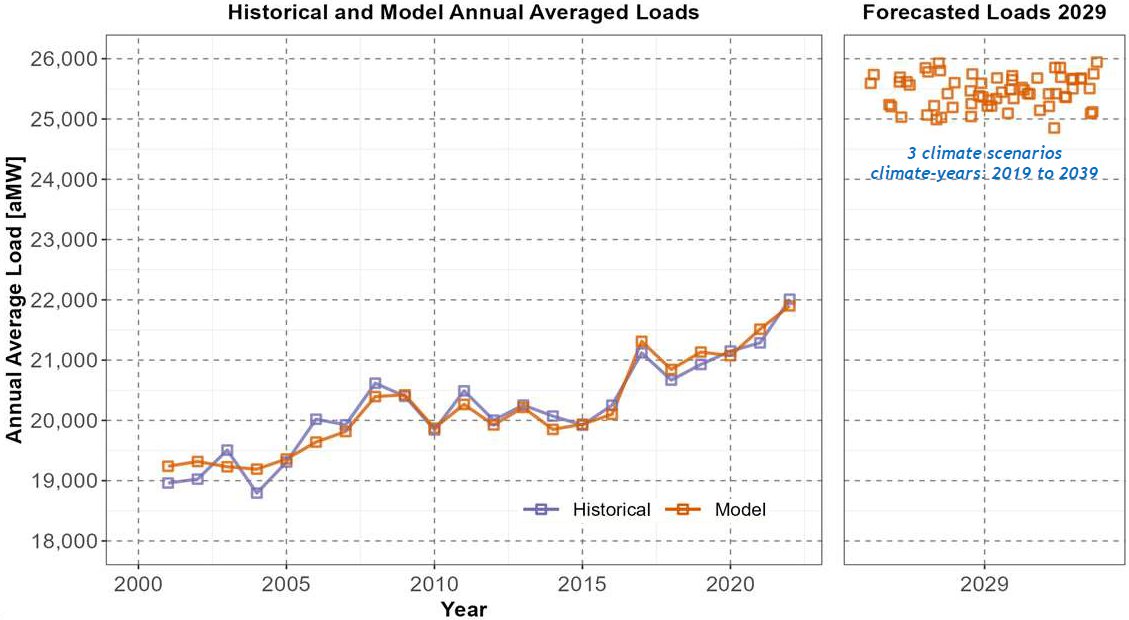Region Continues to Show Progress in Meeting Key Targets from 2021 Power Plan
- May 22, 2024
- Peter Jensen

Power demand forecasts are showing significant increases in the Pacific Northwest over the next five years, and the Council is closely monitoring the region’s progress on key targets from its 2021 Power Plan and analyzing whether that will ensure that the power supply is keeping pace. During its May meeting in Portland, the Council’s Power Committee heard briefings on a new load forecast that looks out to 2029 as well as an update to its mid-term assessment of progress on the 2021 Power Plan.
The load forecast projects that the Northwest will consume between 25,000 and 26,000 average megawatts annually by 2029, compared to its annual consumption of approximately 22,000 average megawatts in 2024. Senior Energy Forecasting Analyst Steve Simmons told the Power Committee that data centers and electric vehicles are two of the primary factors driving the forecasted increases.
Electric vehicles don’t consume much electricity in the Northwest currently, but projected exponential sales growth shows they could account for about 1,000 annual average megawatts, or 4 percent of the overall regional power demand, by 2029. Data centers, computer chip fabrication, and other high-tech uses are also expected to be a significant source of future load growth. In March, Power Division staff presented a tech sector load forecast that projected between 1,700-6,500 average megawatts of new annual demand by 2029. The Power Division is using a base forecast of 2,400 average megawatts for this sector for its upcoming adequacy assessment, as well as testing the high-end forecast in a scenario.
Power System Analyst Dan Hua walked through the 2029 load forecast, and cited several factors that will also contribute to increased power consumption in the Northwest: population growth, weather influencing space heating and cooling demand, economic and job growth, and personal income, among others. (Watch video)

Hua said the Northwest’s population is projected to grow to 15.9 million people in 2029, compared with 15 million in 2021. Since 1995, the Northwest has experienced an increase in demand for space cooling in summer months, although demand for space heating in the colder months of the year continues to be higher. While these are factors influencing load growth to 2029, they’re going to be dwarfed by EVs & the tech sector, Simmons told the committee.
“That growth is really getting blown out by the EVs and the data centers,” Simmons said. “The gorilla in the room is data centers.”
Another portion of the 2029 load forecast looked at hourly needs during peak demand, such as a winter cold snap or a summer heat wave. Peak demand in 2029 is forecasted to be higher than this, Hua told the committee. A hypothetical winter storm hitting the region in February 2029 would consume more than 40,000 megawatts, while a heat wave in July 2029 would exceed 36,000 megawatts of demand. For reference, the June 2021 heat dome lasted for several weeks and peaked in late June, when temperatures reached 116 degrees F in Portland. Power demand in the Northwest peaked at more than 33,000 average megawatts. Power demand during a cold snap in December 2022 slightly surpassed that at more than 34,000 average megawatts.
Power Division staff are also working on a long-term load forecast looking out 20 years, in preparation for the next plan.
Updates on progress for the 2021 Power Plan
Power Division Director Jennifer Light provided an update to the mid-term assessment, which gauges progress on meeting targets in the Council’s 2021 Power Plan and provides recommendations to the region in light of changing power system dynamics. (Watch video) The Council is recommending the region develop resources as aggressively as what is included in the 2021 Plan, but that a risk area would be load growth beyond the baseline loads assumed in the plan. Forecasts for EVs are consistent with what the high EV forecast included in the 2021 Plan, but load growth from data centers & chip manufacturing are significantly higher. The Council continues to see this high load growth as a significant risk area.
At the same time, utilities are making resource decisions that will mitigate, at least somewhat, the risk from these increased loads. These include decisions to invest in more than the Council’s target amount of energy efficiency and changing decisions around coal retirement timelines. The region has already developed around 90% of the minimum renewable build called for by the power plan. Targets for demand response and sufficient reserves also appear to be largely on track.
Power Division staff are working on a 2029 adequacy assessment, which will provide insight on how all these changing dynamics of load and resource decisions will impact resource adequacy. Information on this will allow the Council to continue to update its mid-term assessment of the 2021 Power Plan.



